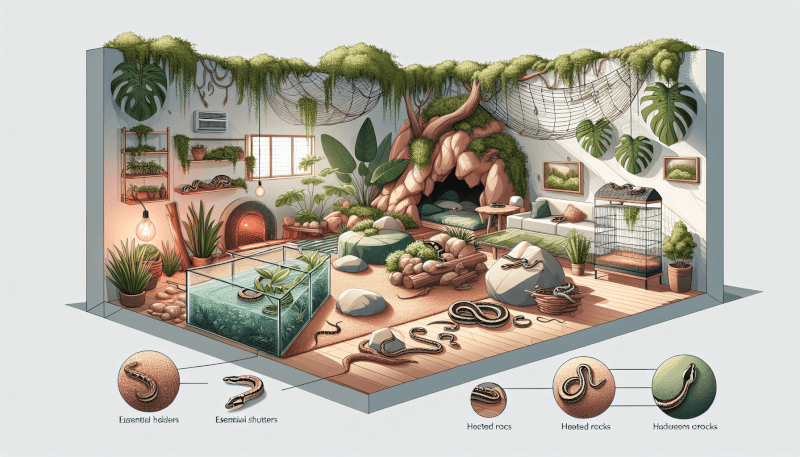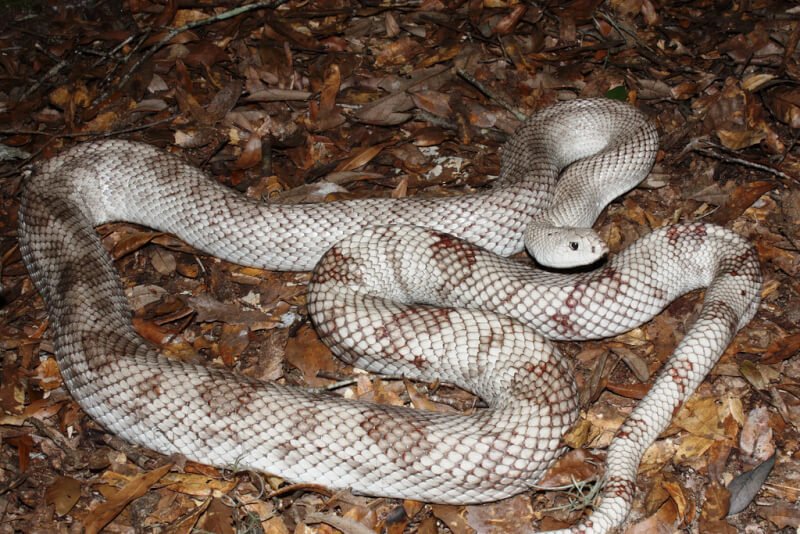Do you have a curious fascination with snakes and want to create a safe haven for these slithering creatures right in your own home? Look no further – in this article, we will explore the wonderful world of creating a snake-friendly habitat in your living space. From providing the perfect hiding spots to creating a suitable feeding area, discover the simple steps you can take to make your home a welcoming environment for these intriguing reptiles. Get ready to embark on a journey of discovery and become a snake enthusiast in your own right!
Choosing the Right Location
Choosing the right location for your snake’s enclosure is crucial to ensure its overall well-being and comfort. Consideration of the local snake species is an important factor to take into account. Different snake species have varying environmental requirements, such as temperature, humidity, and lighting. Research the specific needs of the snake you plan to keep as a pet and choose a location that can accommodate those needs.
Another factor to consider when choosing a location is the available space. Snakes require enough space to move around comfortably. A larger enclosure will provide them with more opportunities for exercise and exploration. Make sure to measure the dimensions of the potential space before setting up the enclosure to ensure it meets the requirements for your snake’s species.
Additionally, determine the ideal temperature for your pet snake. Snakes are ectothermic animals, which means they rely on external heat sources to regulate their body temperature. Research the temperature preferences of your snake species and choose a location or setup that allows you to maintain those temperatures within the enclosure. Providing the right temperature is crucial for the snake’s digestion, metabolism, and overall well-being.
Providing Adequate Shelter
Snakes need a place to feel safe and secure, so providing them with adequate shelter is essential. When it comes to constructing shelters, using natural materials is advisable. Tree bark, rocks, or logs can create a more natural and aesthetically pleasing environment for your snake. This not only serves as a hiding spot but also gives your snake a sense of security and mimics their natural habitat.
Creating enough hiding spots within the enclosure is important to ensure your snake feels secure and has options. Snakes are known to seek out enclosed spaces to feel safe, especially when they are shedding their skin or digesting food. Providing multiple hiding spots, such as caves or rock formations, will allow your snake to choose the spot that suits them best.
In addition to natural hiding spots, installing artificial hideouts is also encouraged. These can be commercially available reptile hides or homemade structures. Again, providing multiple options will allow your snake to choose where they feel most comfortable. Adequate shelter is crucial for reducing stress and promoting a healthy environment for your pet.

Maintaining Suitable Temperature
Maintaining suitable temperatures within the snake enclosure is vital for the overall health and well-being of your pet. Snakes are ectothermic, meaning they rely on external heat sources to regulate their body temperature. To meet the temperature requirements of your snake, offering different temperature zones within the enclosure is necessary.
Using heating devices such as heat lamps, heat pads, or ceramic heaters can help create a temperature gradient. This setup allows the snake to choose the temperature that suits its needs at any given time. The basking area should have a higher temperature, similar to the snake’s natural habitat, while the cooler area should have a lower temperature.
While it’s important to provide heating devices, it’s equally essential to ensure that the enclosure doesn’t become excessively hot. Extreme temperatures can be detrimental to your snake’s health. Regularly monitoring the enclosure’s temperature and using a reliable thermostat can help prevent overheating and maintain a comfortable environment for your pet.
Ensuring Proper Humidity
Proper humidity is crucial for the health and well-being of your snake, as it aids in shedding, digestion, and respiration. Each species of snake has specific humidity requirements based on their natural habitat. Researching the humidity preferences of your snake is crucial to create an appropriate environment.
To increase humidity within the enclosure, misting the enclosure regularly with water is a simple and effective method. This will help create a humid microclimate within the enclosure. You can also use humidity devices such as humidifiers or foggers to maintain the desired humidity level consistently.
Monitoring humidity levels with a hygrometer is essential to ensure they remain within the appropriate range for your snake species. Providing proper humidity is vital for your snake’s overall health and can help prevent issues such as respiratory problems and difficulty shedding.
Implementing Adequate Lighting
Proper lighting is essential for the health and well-being of your pet snake. Install proper lighting fixtures in the enclosure to ensure your snake receives the necessary light exposure. Different snake species have specific lighting needs, ranging from UVB lighting for those that require exposure to ultraviolet light to full-spectrum lighting for others.
Following natural light cycles is essential in providing the right lighting for your snake. This means setting up a lighting schedule that mimics the natural day and night cycles. This regular light-dark cycle helps maintain your snake’s natural behavior and promotes a healthy circadian rhythm.
Providing photoperiods, or specific periods of light exposure, is also important. These photoperiods help regulate your snake’s physiological functions, such as feeding and breeding. It’s recommended to consult with a reptile specialist or herpetologist to determine the appropriate lighting setup for your specific snake species.
Choosing Substrate Wisely
Choosing the right substrate is important for maintaining cleanliness and the overall comfort of your snake. Different species of snakes have varying substrate preferences, so it’s crucial to select substrates that align with your snake’s needs.
Consider both safety and comfort when choosing a substrate. Some common choices include aspen shavings, coconut husk, reptile carpet, or paper towels. These substrates are safe, easy to clean, and suitable for most snake species.
Avoid using toxic or harmful materials as substrates. Certain substances such as cedar chips or chemical-based bedding can release harmful fumes or cause skin irritations in snakes. Choosing a substrate that is safe, non-toxic, and easily replaceable will ensure your snake’s well-being.

Offering Appropriate Food
Providing your snake with adequate and appropriate food is essential for its overall health and well-being. Research the dietary needs of your specific snake species to ensure you are offering a balanced diet.
Snakes are carnivorous animals and typically eat live or pre-killed prey. Depending on the size and species of your snake, the prey can vary from rodents to birds or even other reptiles. It’s important to provide prey that is properly sized for your snake, as offering prey that is too large or too small can lead to feeding difficulties or an inadequate diet.
Consult with a reptile veterinarian or a knowledgeable source to determine the exact diet requirements for your specific snake. Providing the right food in the right quantities will help keep your snake healthy and satisfied.
Maintaining Cleanliness
Maintaining cleanliness within the snake enclosure is crucial for the health of your pet. Regularly cleaning and disinfecting the enclosure is necessary to prevent the buildup of bacteria, parasites, and waste. Remove any waste or shed skin promptly to maintain a clean and hygienic environment for your snake.
Cleaning the enclosure should be done with pet-safe cleaning products. Avoid using harsh chemicals that may be toxic to your snake. There are commercially available reptile-safe cleaning products specifically formulated for disinfecting reptile enclosures. Following the instructions provided with the cleaning products will ensure effective cleaning while keeping your snake safe.
Along with regular cleaning, it’s important to monitor the enclosure for signs of infestation. Parasites such as mites and ticks can pose a risk to your snake’s health. Regularly check your snake for any signs of infestation, such as excessive scratching or visible bugs, and take appropriate action to address the issue.

Ensuring Proper Ventilation
Proper ventilation is crucial for maintaining a healthy environment within the snake enclosure. Sufficient airflow helps prevent the buildup of stagnant air and mold, which can be harmful to your snake. Ensure that the enclosure has proper ventilation to allow fresh air to circulate.
While providing sufficient airflow, it’s important to avoid direct drafts. Snakes are sensitive to drafts and sudden changes in temperature can stress or even harm them. Positioning the enclosure away from doors or windows that may cause drafts is advisable.
For enclosures that may require additional ventilation due to their design, ventilation systems specifically designed for reptile enclosures can be utilized. These systems help maintain a consistent airflow while keeping the enclosure secure and safe for your snake.
Avoiding Harmful Substances
Keeping your snake away from harmful substances is essential to ensure its safety and well-being. Chemicals and pesticides should be kept away from the snake enclosure to prevent potential exposure. Snakes are highly susceptible to chemical toxicity, and even small amounts can be harmful or fatal.
When cleaning the enclosure or handling any materials near your snake, use pet-safe cleaning products. These products are specifically formulated to be safe for reptiles and will not pose a risk of toxicity. Always read the labels of cleaning products to ensure they are suitable for use around reptiles.
In addition to chemicals, ensure a smoke-free environment for your snake. Smoking near the snake enclosure can introduce harmful substances into the air, which can be detrimental to your snake’s health. Maintaining a smoke-free environment will help create a safe and healthy habitat for your snake.
Creating a snake-friendly habitat in your home requires careful consideration of various factors. From choosing the right location to maintaining cleanliness and ensuring proper nutrition, each aspect plays a vital role in providing the best environment for your pet snake. By following these guidelines and doing thorough research about your specific snake species, you can create a safe, comfortable, and enriching habitat for your beloved slithery friend.


